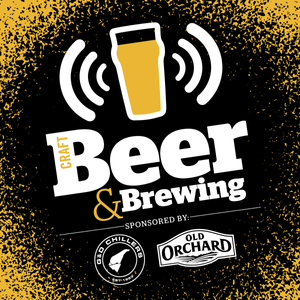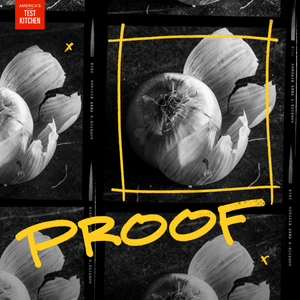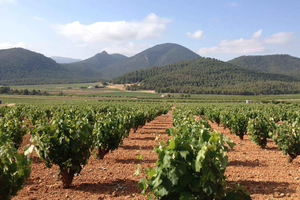
Ep 326: The Best Spanish Wines You've Never Heard of -- Jumilla and Yecla
05/19/20 • 38 min
1 Listener
Tucked into a small corner of southeast Spain is one of the greatest sources for delicious, multi-layered, and decadent reds you’ll find. In the province of Murcia, at latitude 39 ̊N lay two regions of Monastrell (Mourvèdre) production that have quietly churned out wine for more than 3,000 years: Jumilla (joo-ME-yah) and Yecla (YAY-clah).
Today, these regions are magnificent but receive so little press that we can get exquisite bottles that have the fullness, richness and depth for less than US$20.
In the podcast, we take you through the wine history of the region --from the early days with the Phoenicians to the Romans and then the Moors, and then a few strange brushes with the phylloxera root louse that at first propelled the region’s wines, then decimated the land and ultimately saved this area from a fate of nasty bulk production to make it a quiet haven of powerful reds.
We discuss the conditions in Murcia, discuss Bullas, a small Denominacíon de Origen and then we move to the big guns of this area: Jumilla and Yecla.
Jumilla
Jumilla is the best area quality in Murcia and also makes the most wine. Vineyards are spread across a wide valleys and plateaus surrounded by mountains. A few geological and climate facts:
- The high elevation of the vineyards -- between 1,300 -2,600 ft (400 -800 m) make it possible for grapes to cool at night and maintain acidity.
- The soils here are dark and have a high limestone content. They’re permeable but have good moisture retaining properties, allowing the vines during the harsh summer droughts.
- This is a very difficult place to grow things – it’s a harsh, dry, continental climate that is tempered a bit by Mediterranean breezes but is brutal in its dry heat.
Jumilla is one of Spain’s oldest DOs – its historical legacy as a high-quality wine producer is well known in its native land. It now makes whites, reds, and rosés, although the reds are the flagship for the region.
- Red grapes include: Monastrell, Tempranillo (called Cencibel here), Garnacha Tinta, Syrah, Cabernet Sauvignon, Merlot, and Petit Verdot. The French varietals were added to the Monastrell to create more dimension in the finished wine (read: international appeal). This has been critically acclaimed, however some of it muddies the character of the grape.
- White grapes include: Aíren, Macabeo, Pedro Ximenez, Malvasia, Chardonnay, Sauvignon Blanc, Mosacatel de Grano Menudo
- Although not mentioned in the podcast, the Jumilla DO has several areas it draws from: Jumilla, Montealegre, Fuenteálamo, Tobarra, Hellín, Ontur, and Albatana. 40% of the wine is from Jumilla proper.
Monastrell represents 85% of the vines planted and 80% of any blend must be this grape. The character of the wine is superb: it tastes like dark fruit, earth, and minerals with a brambly, gamy character. With age, these flavors mellow to be more like dark soil, coffee and spice.
Although it isn’t prevalent, Jumilla makes rosé from 80% Monastrell too -- in the best versions it’s similar to the rosé of Bandol, in Provence, France with some acidity and tannin and, from a careful producer, the opportunity to potentially have a longer life than 1 year.
Modern technology, good farming and a consistent climate mean there isn’t a lot of vintage variation here although the region does have aging classifications similar to Rioja:
- Vino joven ("young wine") or Sin crianza: little, if any, wood aging.
- Crianza:
- Reds: aged for 1 year total -- at least 6 months in oak, 6 months in the bottle.
- Whites and rosés: at least 1 year with at least 4 months in oak.
- Reserva:
- Reds: aged for at least 2 years -- at least 12 months in oak, 12 months in the bottle.
- Whites and rosés: aged at least 18 months with at least 6 months in oak.
- Gran Reserva: Made only above average vintages.
- Reds: 4 years aging, 12 months of which in oak and a minimum of 36 months in the bottle.
- Whites and rosés: aged for at least 4 years with at least 6 months in oak
Yecla
Towards the end of the show, we discuss the smallest and northernmost wine zone in Murcia, Yecla. This area is landlocked by other DOs: Jumilla DO to the southwest, Almansa DO to the north, and Alicante DO to the east. It’s 50 miles (80km) inland and represents a transition from more coastal Mediterranean influences to hotter, arid continental conditions.
Yecla is similar to Jumilla in that its altitude allows the grapes to maintain acidity at night, creating balance in the wines.
- White grapes: Airen, Macabeo, Merseguera, Malvasia, Moscatel de Grano Menudo, Sauvignon Blanc, Chardonnay. These wines are usually blended. A small amount of sparkling wine is also made here.
- Red grapes: similar to tho...
Tucked into a small corner of southeast Spain is one of the greatest sources for delicious, multi-layered, and decadent reds you’ll find. In the province of Murcia, at latitude 39 ̊N lay two regions of Monastrell (Mourvèdre) production that have quietly churned out wine for more than 3,000 years: Jumilla (joo-ME-yah) and Yecla (YAY-clah).
Today, these regions are magnificent but receive so little press that we can get exquisite bottles that have the fullness, richness and depth for less than US$20.
In the podcast, we take you through the wine history of the region --from the early days with the Phoenicians to the Romans and then the Moors, and then a few strange brushes with the phylloxera root louse that at first propelled the region’s wines, then decimated the land and ultimately saved this area from a fate of nasty bulk production to make it a quiet haven of powerful reds.
We discuss the conditions in Murcia, discuss Bullas, a small Denominacíon de Origen and then we move to the big guns of this area: Jumilla and Yecla.
Jumilla
Jumilla is the best area quality in Murcia and also makes the most wine. Vineyards are spread across a wide valleys and plateaus surrounded by mountains. A few geological and climate facts:
- The high elevation of the vineyards -- between 1,300 -2,600 ft (400 -800 m) make it possible for grapes to cool at night and maintain acidity.
- The soils here are dark and have a high limestone content. They’re permeable but have good moisture retaining properties, allowing the vines during the harsh summer droughts.
- This is a very difficult place to grow things – it’s a harsh, dry, continental climate that is tempered a bit by Mediterranean breezes but is brutal in its dry heat.
Jumilla is one of Spain’s oldest DOs – its historical legacy as a high-quality wine producer is well known in its native land. It now makes whites, reds, and rosés, although the reds are the flagship for the region.
- Red grapes include: Monastrell, Tempranillo (called Cencibel here), Garnacha Tinta, Syrah, Cabernet Sauvignon, Merlot, and Petit Verdot. The French varietals were added to the Monastrell to create more dimension in the finished wine (read: international appeal). This has been critically acclaimed, however some of it muddies the character of the grape.
- White grapes include: Aíren, Macabeo, Pedro Ximenez, Malvasia, Chardonnay, Sauvignon Blanc, Mosacatel de Grano Menudo
- Although not mentioned in the podcast, the Jumilla DO has several areas it draws from: Jumilla, Montealegre, Fuenteálamo, Tobarra, Hellín, Ontur, and Albatana. 40% of the wine is from Jumilla proper.
Monastrell represents 85% of the vines planted and 80% of any blend must be this grape. The character of the wine is superb: it tastes like dark fruit, earth, and minerals with a brambly, gamy character. With age, these flavors mellow to be more like dark soil, coffee and spice.
Although it isn’t prevalent, Jumilla makes rosé from 80% Monastrell too -- in the best versions it’s similar to the rosé of Bandol, in Provence, France with some acidity and tannin and, from a careful producer, the opportunity to potentially have a longer life than 1 year.
Modern technology, good farming and a consistent climate mean there isn’t a lot of vintage variation here although the region does have aging classifications similar to Rioja:
- Vino joven ("young wine") or Sin crianza: little, if any, wood aging.
- Crianza:
- Reds: aged for 1 year total -- at least 6 months in oak, 6 months in the bottle.
- Whites and rosés: at least 1 year with at least 4 months in oak.
- Reserva:
- Reds: aged for at least 2 years -- at least 12 months in oak, 12 months in the bottle.
- Whites and rosés: aged at least 18 months with at least 6 months in oak.
- Gran Reserva: Made only above average vintages.
- Reds: 4 years aging, 12 months of which in oak and a minimum of 36 months in the bottle.
- Whites and rosés: aged for at least 4 years with at least 6 months in oak
Yecla
Towards the end of the show, we discuss the smallest and northernmost wine zone in Murcia, Yecla. This area is landlocked by other DOs: Jumilla DO to the southwest, Almansa DO to the north, and Alicante DO to the east. It’s 50 miles (80km) inland and represents a transition from more coastal Mediterranean influences to hotter, arid continental conditions.
Yecla is similar to Jumilla in that its altitude allows the grapes to maintain acidity at night, creating balance in the wines.
- White grapes: Airen, Macabeo, Merseguera, Malvasia, Moscatel de Grano Menudo, Sauvignon Blanc, Chardonnay. These wines are usually blended. A small amount of sparkling wine is also made here.
- Red grapes: similar to tho...
Previous Episode
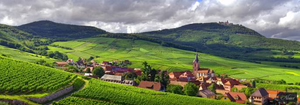
Ep 325: The Greats -- Alsace Riesling
Next Episode
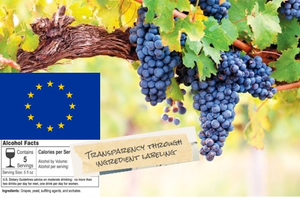
Ep 327: Wine Ingredient Labeling Pushes Forward in the EU -- with Barnaby Eales
If you like this episode you’ll love
Episode Comments
Featured in these lists
Generate a badge
Get a badge for your website that links back to this episode
<a href="https://goodpods.com/podcasts/wine-for-normal-people-39399/ep-326-the-best-spanish-wines-youve-never-heard-of-jumilla-and-yecla-1723543"> <img src="https://storage.googleapis.com/goodpods-images-bucket/badges/generic-badge-1.svg" alt="listen to ep 326: the best spanish wines you've never heard of -- jumilla and yecla on goodpods" style="width: 225px" /> </a>
Copy
